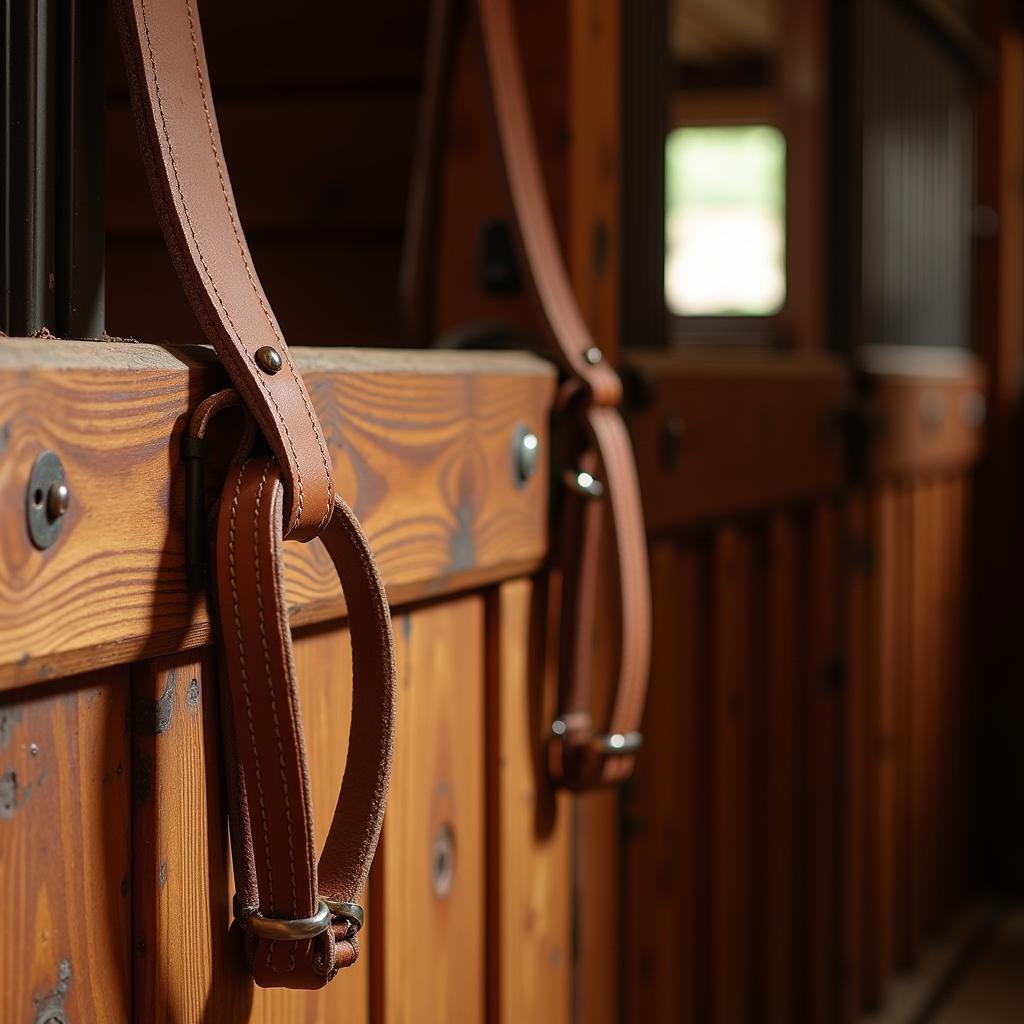Crossties For Horses are a fundamental piece of equipment in any stable, offering a secure way to restrain your equine companion for various tasks. From grooming and tacking up to veterinary checks and even short periods of rest, crossties provide a safe and controlled environment for both horse and handler. Choosing the right type of crossties and ensuring they are installed and used correctly is crucial for your horse’s well-being.
Choosing the Right Crossties for Your Horse
When selecting crossties, consider your horse’s temperament, size, and the primary purpose they will serve. Here’s a breakdown of common types:
- Nylon Crossties: Durable, easy to clean, and affordable, nylon crossties are an excellent choice for most horses. They offer moderate flexibility and are suitable for a wide range of activities.
- Cotton Crossties: Soft and breathable, cotton crossties are gentle on a horse’s skin and are particularly well-suited for horses with sensitive skin. However, they require more frequent cleaning than their nylon counterparts.
- Leather Crossties: Known for their classic look and durability, leather crossties exude elegance and tradition. They are often favored for shows and competitions but require regular conditioning to maintain their suppleness and strength.
 Leather crossties in a horse stable
Leather crossties in a horse stable
Proper Crosstie Installation: Ensuring Safety and Security
Proper installation is essential to guarantee your horse’s safety and the effectiveness of your crossties:
- Secure Anchors: Whether you opt for wall rings, loops, or specialized crosstie brackets, ensure they are securely anchored to a solid structural component of your stable.
- Appropriate Height: The ideal height for crossties is at or slightly above your horse’s withers. This positioning discourages them from trying to get a leg over the ties.
- Quick-Release Snaps: Opt for crossties equipped with quick-release snaps. These safety features allow for a swift release in emergencies, preventing potential injury to your horse should they pull back or panic.
Crosstie Safety: Using Them Responsibly
While crossties offer convenience and control, responsible use is paramount for your horse’s well-being.
- Never Leave Unattended: Always supervise your horse when they are on crossties. Unforeseen circumstances can arise, and your presence is crucial for their safety.
- Gradual Introduction: Introduce crossties gradually, especially with young or inexperienced horses. Start with short periods and gradually increase the duration as they become more comfortable.
- Avoid Over-Tying: Limit the length of the crossties to prevent your horse from lowering its head too far or getting a leg over the ties.
- Regular Inspections: Regularly inspect your crossties for signs of wear and tear, such as fraying, cracking, or damage to hardware. Replace any compromised components promptly.
Crossties: Beyond Basic Restraint
While primarily used for restraint, crossties can also serve as a valuable training tool.
- Teaching Patience: Crossties can help instill patience in young or restless horses by encouraging them to stand quietly for extended periods.
- Desensitization Training: Use crossties as part of a desensitization program to acclimate your horse to clippers, vet equipment, or other potentially stressful stimuli.
“Crossties, when used correctly, are more than just a means of restraint,” says renowned equine behaviorist Dr. Sarah Williams. “They become a versatile tool for building trust, promoting calmness, and enhancing your horse’s overall well-being.”
Conclusion
Crossties are an indispensable tool for any horse owner, offering a safe and controlled environment for a multitude of tasks. By carefully selecting the right type, ensuring proper installation, and adhering to responsible usage guidelines, you can enhance your horse’s safety and comfort while simplifying your daily horse care routine.
FAQs
1. Can I leave my horse unattended on crossties?
No, never leave your horse unattended on crossties.
2. How long can I keep my horse on crossties?
Limit the time to what is necessary for the task at hand, generally no more than a couple of hours.
3. What should I do if my horse panics while on crossties?
If possible, try to remain calm and speak soothingly to your horse. If you can safely reach the quick-release snaps, unclip them to free your horse.
4. How often should I replace my crossties?
Replace them immediately if you notice any damage. Even without visible wear, consider replacing them every 1-2 years, depending on frequency of use.
 Types of horse crossties
Types of horse crossties
For any inquiries or assistance with your horse care needs, please don’t hesitate to contact us at Phone Number: 0772127271, Email: [email protected] Or visit us at QGM2+WX2, Vị Trung, Vị Thuỷ, Hậu Giang, Việt Nam. Our dedicated team is available 24/7 to assist you.